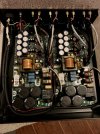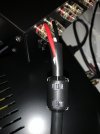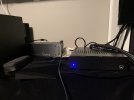What would resonate? I’m curious but a bit out of my depth.
In my simple ham radio mind, oscillation happens at the tuning point of an RLC network, with the resistor providing the damping by lowering the sharpness of the resonance (Q). The speaker provides the R and (possibly) the C, and the amp/wiring provides the inductance, one supposes. Adding resistance as Don suggests would reduce the Q and presumably damp the oscillation to some extent. (And also reduce overall gain, so the comparison would need care, it seems to me.)
Putting ferrites on the speaker wire should add inductance and choke RF frequencies, it seems to me. But if this is an oscillation in the audible band, wouldn’t the speaker wire need to be coiled through the ferrite to create higher inductance and lower the frequency? Of course, that would change the frequency response. Plus, the ferrites are probably clip-on beads designed to choke common-mode RF from a shield, and not big enough to loop wire through them.
But reading back, the ferrites did affect the phenomenon, and that reinforces that even that simple choke inductor at least influenced the problem, which in turn does point the fickle finger of fate to oscillation.
Does the person have the ability to extract the audio from the video so that it can be more easily posted? Or record a new sample using, say, audacity in a computer?Looking at waveforms would be interesting.
A usually reliable poster on another forum reported that his 502 lost something when driving speakers that presented a capacitive load up high (no data obtained or reported, of course). I wonder if that could be related.
Rick “sensing a learning opportunity” Denney



